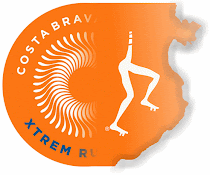Un buen amigo que me eché allí, Patrick Johns, escribió un interesante artículo, el cual me amablemente me mandó en su día.
Apareció en Ultrarunning Magazine, número que no tengo y que algún milagro algún día espero que haga que caiga en mis manos.
In The Shadow of Giants
Runners from 14 nations travel to northern India for a five-day adventure run in the shadows of giants.
By Patrick Johns
Cruising at 35,000 feet and snacking on one of my last curry chicken and rice meals in India, I realized that a difficult journey was coming to an oddly comfortable close. I was returning to Delhi from Bagdogra, India. My new buddy, Urs Weber, from Germany, tapped me on the shoulder and pointed out the window. Just off the wing tip, stabbing up through the clouds was the southern face of Mt. Everest, along with a saw-blade array of some of the tallest peaks in the world. A remarkable view and one so similar to what we had worked so hard to see a few days before. Urs and I had recently finished the final leg of the five-day Himalayan 100 Mile Stage Race and Mt. Everest Challenge Marathon. It seemed odd that we should now enjoy this majestic view without first having to expend a huge amount of energy.
Our conversation drifted back to the experience that we had just shared. Six days before, in the hamlet of Maneybanging, in the Bengal Region of India, 58 participants from around the world met to begin this shared adventure. Of course, their personal starting points and experiences would be different, but ultimately we would end up at the same place.
For me, the journey started several years before when a friend and I decided to attend the 2000 event. This year in 2003, I came better prepared and on a mission. I came this year, not only to participate in the race, but also curious to identify a common thread between this small but diverse group of athletes. Who are these unique people, and what motivates them to travel the world? Was there some one thing that we all had in common, other than the desire to go to a place where one can enjoy a pre-race coffee while gazing at four of five of the world’s tallest mountain peaks?
To open my fellow runners’ personal vaults would take some effort -- a little rooting around in the unique noodles of those who choose to do this equally unique race. But, hey, I’m not shy. Since my first Himalayan 100, I have had plenty of people ask about my motives. I was curious to find out if I’d be better prepared to answer after the second time around.
Pre-Race coffee with four of five of the world’s tallest peaks
A Pack of Adventure Hounds in Maneybanging, West Bengal
Like a pack of adventure loving hounds, this year’s group, the second largest in the event’s 13 year history, would sniff their way to the “fox” in India. In years past, it was typical for about half of the participants to come from the U.S., but this year would be quite different. Only our small and ragtag contingent of six would journey out from the security of the U.S. shores to attend this international shindig, yet in this warm and friendly country of India, the only thing I ever felt threatened by was the challenges of the race itself. When an old “Clydesdale” like me finishes as the second American in any race, there’s something wrong with the picture!
Although the mix of runners has changed over the last few years, the course has not. It follows a trail built in the early 1900’s when The Aga Khan, ruler of much of India, told his men to build him a path. He had heard great tales of a place high in the Himalayas from where it was possible to see four giants, and he wished to travel there. The giants go by the names Everest, Lhotse, Makalu, and Kanchanjunga, which are four of the five world’s tallest peaks. The place is called Sandakpu, and Khan’s trail still exists. Much of the Himalayan 100 Mile Stage Race runs on this trail.
This five day, 100-mile adventure run is divided into 24, 20, 26, 13, and 17-mile stages. Much of the running is done on the border of India and Nepal, at an elevation of 12,000 feet. If you run on the left side of the trail, you are in Nepal, on the right, India. The first and third days are considered the hardest, but none of the days are what I would call easy.
The Aga Khan said
“Build me a trail”
Up and Up We Climbed
Race Day 1 – thought to be the hardest day, the trail climbs a total of 8,000+ vertical feet over 24 miles, following switchbacks up and up on what could best be described as a dangerous path of slippery boulders. On the top at Sandukpa, every runner punches through the daily finish ribbon before stopping his or her clock for the day. After being led to your assigned hut, you find the gear and sleeping bag that you packed the night before. Everything needed for the remaining days is there on your bunk. There is plenty of food and the infamous “bucket bath” of hot water if you choose to be so bold in the cold.
Race Day 2 – starts early with an incredible photo op at sunrise, and the first chance to see the peaks … and they are awesome! Then it’s off to the races, starting at 12,000 feet with a 20 mile out and back run on a roller coaster grade. Everest is on your left and Kanchanjunga on your right. The third tallest mountain in the world, Kanchanjunga is little known outside the climbing community, for it is a highly technical climb, and therefore doesn’t get the press bestowed to Everest. Starting early and finishing early makes this a good day for that “bucket bath”, and a chance to reload some badly needed calories.
Race Day 3 – is “The Mt. Everest Challenge Marathon”. No, you don’t climb or run the 26.2 miles on Mt. Everest, but you certainly can enjoy its view while you set out on the still frozen trail at 6:30 am. Who needs sleep anyway? Most haven’t slept either; my snoring is to blame for that. This day starts early so that most runners can complete the standard marathon distance before sunset. This day’s course repeats the first part of Day 2, winding out along the trail as it spools out like The Great Wall of China. Then you “drop for ten”, miles that is, down a steep washed out rut that seconds as a creek bed during the monsoon season. This wreck of a trail has some of the same shocking elements of the twisted beggars that you see in Delhi. This day finishes in the quaint mountain village of Rimbik. Hearing the sounds from the jungle of birds and rushing water is a great way to compensate for that old inevitable “marathon wall”. Running down through “the jungle rut”, giving back much of the punishing altitude, was the perfect way to finish. The stark contrast from the time at the top with the peaks finished by a jungle adventure run is like nothing else.
Race Days …….. 24, 20, 26, 13, 17
The “Evil Twin”, the Uphill was Waiting
Race Day 4 – starts out on six miles of rough road that is all downhill. But wait! There is the evil twin waiting up the road in the form of the uphill 6 miles. This is just another reminder that even on the easiest day, if you can call it that, there is no free lunch on this course. With a steady climb up the other side of the valley to what will be the starting point for the next and last day’s race, this day is complete.
Race Day 5 – after climbing out of the bus with stiff and cramped legs, you are welcomed with the realization that after you complete a 10k straight up the winding valley wall, you reach a pass that signals the end of all the “up stuff”. Ten more miles to the finish line in Maneybangjang where we started, and ITS ALL DOWNHILL! Time to pick ‘em up and take it to the house. High fives, hugs, lunch, and adult beverages wait for those inclined. Boarding the bus and returning back to Mirik Lake for a hot shower, meal, and the awards ceremony are all that is left to round out this perfect five-day spanking.
The Most Difficult Marathon?
The Most Beautiful Marathon?
These are the questions
“The Himalayan 100” is usually described by two very subjective claims, “One of the most difficult marathons”, and also “The most beautiful marathon in the world”.
About the first: “The most difficult marathon”.
Many of the participants of the HSR/ECM over the years have competed in grueling events like the Race Des Sables (a 150 mile stage race across the Sahara). I didn’t hear even once, the most hard-core runner say that “The Himalayan 100” was any kind of a cakewalk. It is considered by many of the “desert runners” to be the flipside adventure to the desolate, stark, 150 mile run in the sand that has become internationally popular. Anyway you cut it, the words “marathon” and “easy” have never co-existed in the same sentence for me. As for whether or not it’s the hardest, I don’t have that answer, other than to say, it’s the hardest race that I have ever done.
As for the second claim: “The most beautiful marathon in the world”.
This just might be true. Considering that for much of the race you are surrounded by the natural elements of the tallest mountains in the world, animals, rivers, streams, and lush jungle. Then you frost this already delicious cake with the smiling native people along the trail, villages, shrines, and prayer flags flapping in the wind, it might be difficult to beat this claim. Many of the runners maxed out their digital memory card or used up their film well in advance of the last day of the race.
Lay Down Their Arms!!
Apparently this year’s race winners were taken by the beauty. Sergio Fernández and Noel Hana, both tough competitors who would go on to finish 1st and 2nd respectively in the Stage Race, would by choice tie in the Marathon. As they were battling side-by-side up the dangerously slippery cobble trail on Day 1, realizing that they had a good lead on the next pack of runners behind, and they chose to lay down their weapons. Their desire to not let the incredible sights on the course escapes them, led to a temporary cease-fire. The grandeur overpowered their competitive desire to win, as they chose to play a game of photo op leapfrog and passed their cameras back and forth, taking pictures of each other. Using the incredible backdrop that appeared around each corner to frame their pictures, they more importantly framed a friendship and a bond between a Spaniard and an Irishman that will last forever. These two men finished the marathon side by side in a first ever split finish.
From the ladies camp, here too the trophies would be split. The overall stage race award went to Lynne Stark from Ireland, and a proud marathon win to Gretha Peterson from Denmark. Plugging along not too far behind was another close race which included “World class ultra runner”, Hilary Walker. Hilary was moving along nicely considering she was nursing a broken hand from a fall on Day 1 that had been temporarily patched.
Namaste! Namaste! Namaste!
The race director, Mr. Pandey, demonstrated to everyone his skills in organizing one of the most difficult logistical events in the world. He treated each of his guests with true hospitality and, through his actions, was subliminally teaching us the meaning of the word “Namaste”, the same word that we were showered with by the local villagers along the trail. “Namaste” has much deeper significance than simply saying “hello”.
“The Himalayan 100” boasts a 95% completion rate, which is even more amazing when considering that participants have ranged in age from 13 to 75. Doing what it takes to insure the satisfaction of a safe completion by all participants is a major goal of the always-present race doctor and Mr. Pandey. After all, the participants have traveled a long way to get here.
Here is a story for the books: Several years ago, a Japanese runner had become dehydrated during the very last stages of the ascent on Day 1. Under the constant supervision of the Race Doctor, she was allowed a jeep mounted moving I.V. drip. She slowly advanced behind the vehicle up the mountain to the finish line for Day 1. Then a hot meal, more fluids, and some rest were all she needed to go on. After four more days of racing, she had an overall successful finish. Yes, this is extreme, but still very cool.
Ages ranging from 13 to 75
Now Back to My Original Question
This does however, make me stop and think once again about my original question. The curiosity I had about a common thread or motivation among the group didn’t take much rooting around to satisfy. Call it what you like, but I could see it in the eyes; “focus” seemed to be an obvious attribute, seasoned with a good amount of “determination”. No real surprise, though, when the act of doing the sport itself, Adventure Trail Running, requires attention and focus with every step. Some came to win and others just to finish, but we would all leave India and the “Himalayan 100” changed.
I wouldn’t be so foolish as to recommend this event to everybody because it does truly possess many of the elements of a good old fashioned “butt whipping”. We all know that rarely do the special things in life come without some sort of a price tag. If you are willing to endure a little hardship, commit to max effort for a few days, and use a little common sense, you will finish the race and your life will be changed. There is little doubt that if you push the ends of your own “effort spectrum” further apart, you are guaranteed to reexamine your definition of “hard” and in doing so, make other challenges seem easier. This is a group of people who believe this and are willing to pay that price. You will also grant yourself the privilege of making life long friends from around the world. Friends who maybe speak a completely different language but still are connected in very special way. And yes, for me, although no less difficult, it was much better the second time around. Namaste!
From the camp at the top there is a sign that reads
“Leave Nothing But Your Footprints –
Take Nothing But Your Memories”
Posteriormente me mandó otro artículo, correspondiente a la siguiente edición, la de 2004: Darjeeling Story
+: In The Shadow of Giants, Himalayan Stage Race
+s13: Index: Mis otras ultramaratones
In The Shadow of Giants
viernes, 7 de noviembre de 2003
Suscribirse a:
Enviar comentarios (Atom)











0 comentarios:
Publicar un comentario